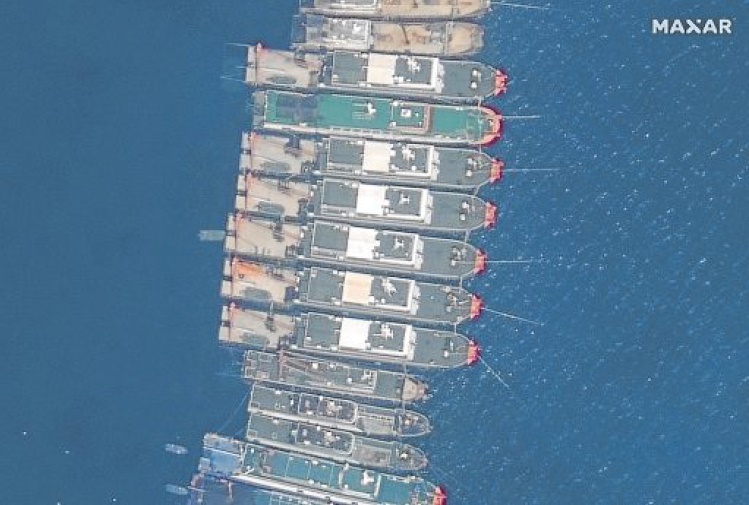
SUSTAINED PRESENCE Now numbering close to 200, the Chinese vessels seen gathered at Juan Felipe (Whitsun) Reef
have been coming and going since late last year, according to the US-based research company Simularity. —AFP
The presence of Chinese vessels at a reef within the country’s exclusive economic zone (EEZ), which had aroused the concern of President Rodrigo Duterte, was detected by a US-based research company as early as November last year.
Philippine military forces reported sighting the vessels, which they believed to be manned by Chinese maritime militia members, at the Julian Felipe (Whitsun) Reef only early this month.
But Simularity, a research company that analyzes satellite data, said it first documented the Chinese vessels in November 2020 and that a large number had been “mooring, arriving and departing at Whitsun Reef since mid-December 2020.”
The number of ships anchored at the reef went down briefly in early February, but those arriving and departing were “still substantial,” according to Simularity.
In December, there were around 20 ships with an average width of 10 meters, it said, noting that with such configuration “fishing is impossible.”
‘New information’
On March 24, it counted about 200 vessels stil at the reef and that “most are probable Chinese fishing vessels, and a few are probable Chinese Coast Guard vessels.”
Defense Secretary Delfin Lorenzana declined to give an immediate comment, saying the satellite images were “new information” which the Philippine government did not have.
On March 20, the National Task Force for the West Philippine Sea confirmed a March 7 report of the Philippine Coast Guard that around 220 Chinese vessels were moored in formation at Julian Felipe Reef.
The reef is a large boomerang-shaped shallow coral reef at the northeast of Pagkakaisa Banks and Reefs (Union Reefs), about 324 kilometers west of Bataraza, a town at the southern tip of Palawan province.
It is within the Philippines’ 370-kilometer EEZ, which means the country has the exclusive right to exploit or conserve any resources in the area, such as fish, oil and natural gas.
Simularity this week also released satellite images showing land reconstruction at Zamora (Subi) Reef, which is just 26 kilometers southwest of Pag-asa, the biggest island occupied by the Philippines also within the country’s EEZ.
Mr. Duterte had spoken with Chinese Ambassador Huang Xilian about the large number of Chinese vessels at the reef, according to presidential spokesperson Harry Roque.
“The President said we were concerned, that any country would be concerned with that many ships,” Roque said.
He also said Mr. Duterte reasserted the international arbitral tribunal’s 2016 ruling that invalidated China’s sweeping claims to the South China Sea.
Huang explained that these were just fishing vessels, not maritime militias, which had sought shelter at the reef because of bad weather.
Gregory Poling, executive director of Asia Maritime Transparency Initiative, also believes the ships belong to the Chinese maritime militia, an auxiliary force for the Chinese People’s Liberation Army.
PH must rally int’l pressure
On March 21, a day after the Philippine military reported the swarm of Chinese vessels at the Julian Felipe Reef, the Philippines filed a diplomatic protest and demanded that the ships leave.
Beijing appears to have ignored Manila’s demand.
Poling said the Chinese would not leave Julian Felipe so that it could solidify its claim on the reef, similar to what it did to other disputed territories in the Spratly Islands.
“The long-term goal for the Philippines really has to be to rally international pressure to convince Beijing that it cannot be a global leader if it continues to treat its neighbors this way,” Poling said in an interview with CNN Philippines on Thursday.
“China must be called out for this kind of illegal behavior and be treated as the rogue actor that it really is. Otherwise, Beijing will continue to behave this way because it pays no price for it internationally,” he added.
According to Poling, with the refusal of the Chinese government to heed the call of the Philippine government, it was now time for the Duterte administration to reconsider its foreign policy pivot to China.
“The Philippines has not really asked for support for the West Philippine Sea issue for the last five years. It is now quite clear that Beijing has not responded positively to President Duterte’s pro-China policy,” he said.